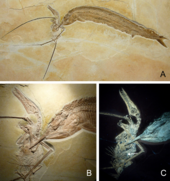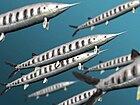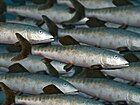Aspidorhynchus
| Aspidorhynchus Temporal range:
| |
|---|---|

| |
| Fossil ofAspidorhynchus sanzenbacheri | |
| Scientific classification | |
| Domain: | Eukaryota |
| Kingdom: | Animalia |
| Phylum: | Chordata |
| Class: | Actinopterygii |
| Order: | †Aspidorhynchiformes |
| Family: | †Aspidorhynchidae |
| Genus: | †Aspidorhynchus Agassiz,1833 |
| Type species | |
| †Esox acutirostris Blainville,1818
| |
| Species | |
|
See text | |
Aspidorhynchus(fromGreek:ᾰ̓σπίςaspís'shield' andGreek:ῥύγχοςrhúnkhos'snout') is an extinct genus of predatoryray-finned fishfrom the Middle Jurassic to the earliest Cretaceous. Fossils have been found in Europe, Antarctica and the Caribbean.[1]
Aspidorhynchuswas a slender, fast-swimming fish, some species reach 85 centimetres (2.79 ft) long,[1]with tooth-lined, elongated jaws. It also had heavy scales and a symmetrical tail. The upper jaw was longer than the lower jaw, ending in a toothless spike. Although it would have looked superficially similar to the present daygars,it was not related to them, belonging to theAspidorhynchiformes,an extinct group of fish noted for their elongatedrostrums.Aspidorhynchiformes are generally considered early relatives ofteleosts.[2]
Taxonomy
[edit]
Aspidorhynchuscontains the following species:[3]
- †A. acutirostris(Blainville,1818) [originallyEsox]-Kimmeridgianof Germany (Nusplingen Limestone)
- †?A. antarcticusRichter & Thompson, 1989-TithonianofJames Ross Island,Antarctica (Ameghino Formation)
- †A. arawakiBrito, 1997-OxfordianofCuba(Jagua Formation)
- †A. crassusWoodward, 1890-Bathonianof England (Taynton Limestone Formation)
- †A. euodusEgerton, 1845-Callovianof England (Oxford Clay)
- †A. fisheriEgerton, 1845-Berriasianof England (Purbeck Group)
- †A. ornatissimusAgassiz, 1834- Tithonian of Germany (Solnhofen Formation)[4]
- †A. sanzenbacheriBrito and Ebert, 2009- Tithonian of Germany (Solnhofen Formation)
A. antarcticusis known from Jurassic remains reworked into theAlbianWhisky Bay Formation,and was the oldestneopterygianfossil discovered in Antarctica at the time.[5]However, some studies have instead classified it inVinctifer,which was later also identified from the same formation.[6]Other species previously classified inAspidorhynchus,such asA. comptoni,have also since been moved toVinctifer,whereas others have been moved toBelonostomus.
A potential species,A. montissanctiGorjanović-Kramberger, 1895is known from theCenomanianofSlovenia.[3]
Ecology
[edit]

Several limestone slabs have been discovered in which fossils ofRhamphorhynchusare found in close association withAspidorhynchus.In one of these specimens, the jaws of anAspidorhynchuspass through the wings of theRhamphorhynchusspecimen. TheRhamphorhynchusalso has the remains of a small fish, possiblyLeptolepides,in its throat. This slab, cataloged as WDC CSG 255, may represent two levels of predation; one byRhamphorhynchusand one byAspidorhynchus.In a 2012 description of WDC CSG 255, researchers proposed that theRhamphorhynchusindividual had just caught aLeptolepideswhile it was flying low over a body of water. As theLeptolepideswas travelling down itspharynx,a largeAspidorhynchuswould have attacked from below the water, puncturing the left wing membrane of theRhamphorhynchuswith its sharprostrum.The teeth in its snout were ensnared in the fibrous tissue of the wing membrane, and as the fish thrashed to release itself the left wing of theRhamphorhynchuswas pulled backward into the distorted position seen in the fossil. The encounter resulted in the death of both individuals, most likely because the two animals sank into ananoxiclayer in the water body, depriving the fish of oxygen. The two may have been preserved together as the weight of the head of theAspidorhynchusheld down the much lighter body of theRhamphorhynchus.[7]
References
[edit]- ^abLópez-Arbarello, Adriana; Schröder, Kerstin M. (June 2014)."The species of Aspidorhynchus Agassiz, 1833 (Neopterygii, Aspidorhynchiformes) from the Jurassic plattenkalks of Southern Germany".Paläontologische Zeitschrift.88(2): 167–185.doi:10.1007/s12542-013-0187-z.ISSN0031-0220.S2CID84101462.
- ^Nelson, J. S.; Grande, T. C.; Wilson, M. V. H. (2016).Fishes of the World(5th ed.).John Wiley & Sons.ISBN9781118342336.
- ^ab"PBDB Taxon".paleobiodb.org.Retrieved2024-05-14.
- ^López-Arbarello, Adriana; Schröder, Kerstin M. (2014-06-01)."The species of Aspidorhynchus Agassiz, 1833 (Neopterygii, Aspidorhynchiformes) from the Jurassic plattenkalks of Southern Germany".Paläontologische Zeitschrift.88(2): 167–185.doi:10.1007/s12542-013-0187-z.ISSN1867-6812.
- ^Richter, Martha; Thomson, M. R. A. (1989)."First Aspidorhynchidae (Pisces: Teleostei) from Antarctica".Antarctic Science.1(1): 57–64.doi:10.1017/S0954102089000106.ISSN1365-2079.
- ^Arratia, Gloria; Scasso, Roberto A.; Kiessling, Wolfgang (2004-03-25)."Late Jurassic fishes from Longing Gap, Antarctic Peninsula".Journal of Vertebrate Paleontology.24(1): 41–55.doi:10.1671/1952-4.hdl:11336/91532.ISSN0272-4634.
- ^Frey, E.; and Tischlinger, H. (2012)."The Late Jurassic pterosaurRhamphorhynchus,a frequent victim of the ganoid fishAspidorhynchus?".PLOS ONE.7(3): e31945.doi:10.1371/journal.pone.0031945.PMC3296705.PMID22412850.
- Prehistoric ray-finned fish genera
- Aspidorhynchiformes
- Middle Jurassic bony fish
- Late Jurassic bony fish
- Early Cretaceous bony fish
- Middle Jurassic fish of Europe
- Late Jurassic fish of Europe
- Jurassic fish of North America
- Early Cretaceous fish of Europe
- Prehistoric fish of Antarctica
- Mesozoic vertebrates of Antarctica
- Fossils of England
- Fossils of France
- Fossils of Cuba
- Fossils of Germany
- Solnhofen fauna
- Bathonian genus first appearances
- Callovian genera
- Kimmeridgian genera
- Tithonian genera
- Berriasian genus extinctions
- Fossil taxa described in 1833
- Taxa named by Louis Agassiz
- Jurassic fish stubs







